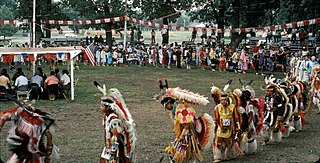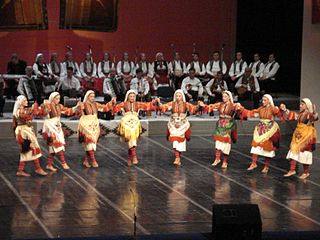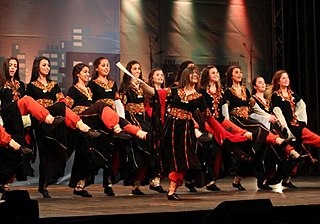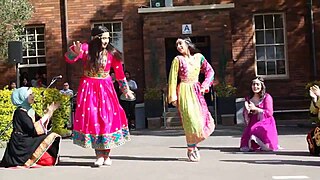
A powwow is a gathering with dances held by many Native American and First Nations communities. Powwows today are an opportunity for Indigenous people to socialize, dance, sing, and honor their cultures. Powwows may be private or public, indoors or outdoors. Dancing events can be competitive with monetary prizes. Powwows vary in length from single-day to weeklong events.

Hora, also known as horo and oro, is a type of circle dance originating in Aromanian and Romanian communities, especially in Romania and Moldova. It is also found in other South East European countries and culturally adopted by ethnic minorities such as the Ashkenazi Jews and the Roma.

A cèilidh or céilí is a traditional Scottish and Irish social gathering. In its most basic form, it simply means a social visit. In contemporary usage, it usually involves dancing and playing Gaelic folk music, either at a home or a larger concert at a social hall or other community gathering place.

Circle dance, or chain dance, is a style of social dance done in a circle, semicircle or a curved line to musical accompaniment, such as rhythm instruments and singing, and is a type of dance where anyone can join in without the need of partners. Unlike line dancing, circle dancers are in physical contact with each other; the connection is made by hand-to-hand, finger-to-finger or hands-on-shoulders, where they follow the leader around the dance floor. Ranging from gentle to energetic, the dance can be an uplifting group experience or part of a meditation.

Kolo is a South Slavic circle dance, found under this name in Bosnia and Herzegovina, Croatia and Serbia. It is inscribed on the UNESCO List of Intagible Cultural Heritage for Serbia.
The music of Thrace, a region in Southeastern Europe spread over southern Bulgaria, northeastern Greece, and European Turkey, contains a written history that extends back to the antiquity, when Orpheus became a legendary musician and lived close to Olympus. Though the Thracian people were eventually assimilated by surrounding Balkan groups, elements of Thracian folk music continue.
Sousta is a Greek folk dance, performed at weddings as an activity of courtship between husband and wife. It originates from Ancient Greece, and holds prominence in Dodecanese Islands, and broader Aegean region. It is the second most common Greek dance, after the Syrtos, with many Greek islands and villages adopting their own version. The performance of the dance reflects various gender roles, inter-played with values of romance and marriage. The Sousta acted as a socialisation process between the youth of a village, evolving into a dance central to these youth as they grew up and formed relationships with others. Socially, the Sousta also functioned as a visible verification of courtship, namely paying respects to the wife and her family. The Sousta is most commonly performed as a three-step dance, with a 'hopping' motion and crossed-over hands.

Dabke is a Levantine folk dance. Dabke combines circle dance and line dancing and is widely performed at weddings and other joyous occasions. The line forms from right to left and the leader of the dabke heads the line, alternating between facing the audience and the other dancers. In English, it can be transcribed as dabka, dabki, dabkeh.

The stomp dance is performed by various Eastern Woodland tribes and Native American communities in the United States, including the Muscogee, Yuchi, Cherokee, Chickasaw, Choctaw, Delaware, Miami, Caddo, Tuscarora, Ottawa, Quapaw, Peoria, Shawnee, Seminole, Natchez, and Seneca-Cayuga tribes. Stomp dance communities are active in Georgia, North Carolina, Oklahoma, Alabama, Mississippi, and Florida.
Khattak Attan (Dance) (Pashto: خټک اتڼ, Urdu: رقص خٹک ) is a swift martial attan dance usually performed while carrying a sword and a handkerchief (while not always are they holding a sword and handkerchief) by the tribesmen from the agile Khattak tribe of Pashtuns. Khattak dance is also the National dance of Pakistan.
The dance forms of Andhra Pradesh take on a wide variety of colors, costumes, and types; and involve different settings and musical instruments.
Gair dance is one of the popular, famous folk dances from Rajasthan in India which is mostly performed by the Bhil community but found in all over Rajasthan.

Attan, the national dance of Afghanistan, is a traditional dance originating from the tribal Pashtun regions. The dance is performed during weddings or other celebrations. The Attan was also conducted by Pashtuns in times of war such as the British occupation and the Pashtun resistance movement, when Pashtuns used the dance to instil confidence and energy among warriors readying to battle the colonisers. It is now considered the national dance of Afghanistan, popularly carried by other ethnic groups in Afghanistan as well as by the Pashtun ethnic group in Pakistan.
The traditional dances of Himachal Pradesh are very complicated. These dances are a vital part of tribal life. It reflects the culture and the tradition of Himachal. Hardly any festivity there is celebrated without dancing. Dance forms such as Nati are performed all over the region.
Tamil Nadu has a rich history of art and entertainment. The three modes of entertainment classified as Iyel (Literature), Isai (Music) and Nadagam (Drama) had their roots in the rural folk theatre like Theru Koothu. Many forms of group and individual dances with the classical forms for popularity and sheer entertainment value. Some of the dance forms are performed by Tribal people. The majority of these dances are still thriving in Tamil Nadu today.
Syrtos is – in classical and modern Greece – a traditional dance in which the dancers link hands to form a chain or circle, headed by a leader who intermittently breaks away to perform improvised steps.

Khigga is a style of Assyrian folk dance in which multiple dancers hold each other's hands and form a semi-circle or a curved line. There are multiple foot patterns that dancers perform. Its thought to have been danced for thousands of years. It is one of the most common and simplest Assyrian folk dances, generally performed at weddings, baptisms, confirmations and other joyous occasions. Set in common time, khigga is accompanied by a moderate dance beat and is usually performed to Assyrian folk and pop music.

Italian folk dance has been an integral part of Italian culture for centuries. Dance has been a continuous thread in Italian life from Dante through the Renaissance, the advent of the tarantella in Southern Italy, and the modern revivals of folk music and dance.
Several folk dance forms evolved in different regions of Odisha, Odissi and Chhau being some popular forms. Sambalpuri dance is most popular dance of western Odisha and is enjoyed by many.











